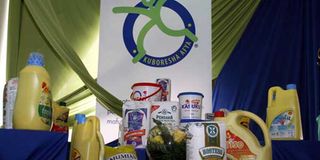Kenya gets Sh2bn to fortify flour, oil and sugar

A display of the foods that have the fortified logo. PHOTO | FILE | NATION MEDIA GROUP
What you need to know:
- Fortification is the addition of micronutrients such as vitamins to foods during manufacturing and processing.
- The national prevalence of iron deficiency among non-expectant women is about 22 per cent.
Kenya has received €19 million (Sh2.1 billion) to support food fortification as it fights malnutrition.
Fortification is the addition of micronutrients such as vitamins to foods during manufacturing and processing.
In Kenya, it is mandatory that maize, wheat and oil be fortified.
EU head of Cooperation in Kenya Erik Habers said the project would target the most vulnerable people, especially women and children.
According to the 2014 Kenya Demographic Health Survey, 26 per cent of the country’s children under five are undernourished, while many expectant women experience anaemia.
HIDDEN HUNGER
“Deficiency of elements such as vitamin A, iron and zinc results in hidden hunger,” Ms Gladys Mugambi, the head of nutrition at the Ministry of Health, said.
The impact of this type of hunger on the body is devastating because people look healthy.
“The results are irreversible. The body cannot fight illnesses because its immunity is compromised,” she said.
The national prevalence of iron deficiency among non-expectant women is about 22 per cent, according to the ministry.
The six-year project will be implemented by Jomo Kenyatta University of Agriculture and Technology in partnership with the ministry and private organisations.
BEYOND REACH
Kenya’s wheat and maize flour, sugar, oil and fats fortification standards were developed from 2005 to 2008.
The ministry’s target for individuals getting fortified meals was 27 million, an objective that is yet to be reached.
Health CS Cleopa Mailu said the project would strengthen governance and the legal framework for the National Fortification Programme.
Maize is consumed by almost 80 per cent of Kenyan women and children, according to the nutrition department.
PROMOTION OF AGRICULTURE
Unfortunately, the fortified flour is beyond the reach of most Kenyans.
Only large millers fortify their maize flour. It accounts for just 40 per cent of the flour consumed in the country.
The Global Alliance for Improved Nutrition, Premix-Suppliers, industrial players in flour, oil, salt and consumer organisations would also be part of the project.
Mr Habers said an additional €9 million would be dedicated to the promotion of agriculture.





